Interlaminar Properties of Prepregs Reinforced with Multiwalled Carbon Nanotubes/Graphene Oxide
Abstract
1. Introduction
2. Materials
2.1. Prepreg Preparation
2.2. Multifilament Tensile Test
2.3. Preparation of the Short Beam Shear Sample
2.4. Testing and Characterization
3. Results and Discussion
3.1. The Performance of the Prepreg Prepared by Melt Mixing
3.2. The Ability of MWCNT/GO to Bond with the Resin
3.3. Interlayer Shear Strength of the Braided Composite
3.4. Analysis of the Interlayer Reinforcement of Short Beam Samples with MWCNT/GO
3.4.1. Fracture Surface Analysis
3.4.2. Synergistic Enhancement Analysis
4. Conclusions
Author Contributions
Funding
Institutional Review Board Statement
Informed Consent Statement
Data Availability Statement
Conflicts of Interest
References
- Santos, P.; Silva, A.P.; Reis, P.N.B. Effect of Carbon Nanofibers on the Strain Rate and Interlaminar Shear Strength of Carbon/Epoxy Composites. Materials 2023, 16, 4332. [Google Scholar] [CrossRef] [PubMed]
- Das, T.K.; Ghosh, P.; Das, N.C. Preparation, Development, Outcomes, and Application Versatility of Carbon Fiber-Based Polymer Composites: A Review. Adv. Compos. Hybrid Mater. 2019, 2, 214–233. [Google Scholar] [CrossRef]
- Zheng, H.; Zhang, W.; Li, B.; Zhu, J.; Wang, C.; Song, G.; Wu, G.; Yang, X.; Huang, Y.; Ma, L. Recent Advances of Interphases in Carbon Fiber-Reinforced Polymer Composites: A Review. Compos. B Eng. 2022, 233, 109639. [Google Scholar] [CrossRef]
- Rajak, D.; Pagar, D.; Menezes, P.; Linul, E. Fiber-Reinforced Polymer Composites: Manufacturing, Properties, and Applications. Polymers 2019, 11, 1667. [Google Scholar] [CrossRef] [PubMed]
- Barthelemy, H.; Weber, M.; Barbier, F. Hydrogen Storage: Recent Improvements and Industrial Perspectives. Int. J. Hydrogen Energy 2017, 42, 7254–7262. [Google Scholar] [CrossRef]
- Lu, C.; Qiu, S.; Lu, X.; Wang, J.; Xiao, L.; Zheng, T. Enhancing the Interfacial Strength of Carbon Fiber/Poly(Ether Ether Ketone) Hybrid Composites by Plasma Treatments. Polymers 2019, 11, 753. [Google Scholar] [CrossRef]
- Shi, L.; Song, G.; Li, P.; Li, X.; Pan, D.; Huang, Y.; Ma, L.; Guo, Z. Enhancing Interfacial Performance of Epoxy Resin Composites via In-Situ Nucleophilic Addition Polymerization Modification of Carbon Fibers with Hyperbranched Polyimidazole. Compos. Sci. Technol. 2021, 201, 108522. [Google Scholar] [CrossRef]
- Ma, L.; Zhu, Y.; Feng, P.; Song, G.; Huang, Y.; Liu, H.; Zhang, J.; Fan, J.; Hou, H.; Guo, Z. Reinforcing Carbon Fiber Epoxy Composites with Triazine Derivatives Functionalized Graphene Oxide Modified Sizing Agent. Compos. B Eng. 2019, 176, 107078. [Google Scholar] [CrossRef]
- Cepero, F.; García, I.G.; Justo, J.; Mantič, V.; París, F. An Experimental Study of the Translaminar Fracture Toughnesses in Composites for Different Crack Growth Directions, Parallel and Transverse to the Fiber Direction. Compos. Sci. Technol. 2019, 181, 107679. [Google Scholar] [CrossRef]
- Sato, N.; Hojo, M.; Nishikawa, M. Intralaminar Fatigue Crack Growth Properties of Conventional and Interlayer Toughened CFRP Laminate under Mode I Loading. Compos. Part A Appl. Sci. Manuf. 2015, 68, 202–211. [Google Scholar] [CrossRef]
- Gao, X.; Umair, M.; Nawab, Y.; Latif, Z.; Ahmad, S.; Siddique, A.; Yang, H. Mode I Fatigue of Fibre Reinforced Polymeric Composites: A Review. Polymers 2022, 14, 4558. [Google Scholar] [CrossRef]
- Tran, M.Q.; Ho, K.K.C.; Kalinka, G.; Shaffer, M.S.P.; Bismarck, A. Carbon Fibre Reinforced Poly(Vinylidene Fluoride): Impact of Matrix Modification on Fibre/Polymer Adhesion. Compos. Sci. Technol. 2008, 68, 1766–1776. [Google Scholar] [CrossRef]
- Seo, M.K.; Park, S.J. Surface Characteristics of Carbon Fibers Modified by Direct Oxyfluorination. J. Colloid Interface Sci. 2009, 330, 237–242. [Google Scholar] [CrossRef]
- Lan, B.; Liu, Y.; Mo, S.; He, M.; Zhai, L.; Fan, L. Interlaminar Fracture Behavior of Carbon Fiber/Polyimide Composites Toughened by Interleaving Thermoplastic Polyimide Fiber Veils. Materials 2021, 14, 2695. [Google Scholar] [CrossRef] [PubMed]
- Ke, H.; Zhao, L.; Zhang, X.; Qiao, Y.; Wang, G.; Wang, X. Performance of High-Temperature Thermosetting Polyimide Composites Modified with Thermoplastic Polyimide. Polym. Test 2020, 90, 106746. [Google Scholar] [CrossRef]
- Li, M.; Che, Z.; Wang, S.; Zhou, Y.; Fu, H.; Gu, Y.; Zhang, W. Tuning Interlaminar Fracture Toughness of Fine Z-Pin Reinforced Polymer Composite. Mater. Des. 2021, 212, 110293. [Google Scholar] [CrossRef]
- Wazalwar, R.; Sahu, M.; Raichur, A.M. Mechanical Properties of Aerospace Epoxy Composites Reinforced with 2D Nano-Fillers: Current Status and Road to Industrialization. Nanoscale Adv. 2021, 3, 2741–2776. [Google Scholar] [CrossRef] [PubMed]
- Kumar, M.; Kumar, P.; Bhadauria, S.S. Interlaminar Fracture Toughness and Fatigue Fracture of Continuous Fiber-Reinforced Polymer Composites with Carbon-Based Nanoreinforcements: A Review. Polym.-Plast. Technol. Mater. 2020, 59, 1041–1076. [Google Scholar] [CrossRef]
- Wetzel, B.; Rosso, P.; Haupert, F.; Friedrich, K. Epoxy Nanocomposites–Fracture and Toughening Mechanisms. Eng. Fract. Mech. 2006, 73, 2375–2398. [Google Scholar] [CrossRef]
- Sprenger, S. Improving Mechanical Properties of Fiber-Reinforced Composites Based on Epoxy Resins Containing Industrial Surface-Modified Silica Nanoparticles: Review and Outlook. J. Compos. Mater. 2015, 49, 53–63. [Google Scholar] [CrossRef]
- Zheng, Y.; Wang, X.; Wu, G. Facile Strategy of Improving Interfacial Strength of Silicone Resin Composites through Self-Polymerized Polydopamine Followed via the Sol-Gel Growing of Silica Nanoparticles onto Carbon Fiber. Polymers 2019, 11, 1639. [Google Scholar] [CrossRef] [PubMed]
- Liu, W.; Li, L.; Zhang, S.; Yang, F.; Wang, R. Mechanical Properties of Carbon Nanotube/Carbon Fiber Reinforced Thermoplastic Polymer Composite. Polym. Compos. 2017, 38, 2001–2008. [Google Scholar] [CrossRef]
- Lyu, H.; Jiang, N.; Li, Y.; Lee, H.; Zhang, D. Enhanced Interfacial and Mechanical Properties of Carbon Fiber/PEEK Composites by Hydroxylated PEEK and Carbon Nanotubes. Compos. Part A Appl. Sci. Manuf. 2021, 145, 106364. [Google Scholar] [CrossRef]
- Lyu, H.; Jiang, N.; Li, Y.; Zhang, D. Enhancing CF/PEEK Interfacial Adhesion by Modified PEEK Grafted with Carbon Nanotubes. Compos. Sci. Technol. 2021, 210, 108831. [Google Scholar] [CrossRef]
- Tiwari, S.K.; Sahoo, S.; Wang, N.; Huczko, A. Graphene Research and Their Outputs: Status and Prospect. J. Sci. Adv. Mater. Devices 2020, 5, 10–29. [Google Scholar] [CrossRef]
- Almuhammadi, K.; Alfano, M.; Yang, Y.; Lubineau, G. Analysis of Interlaminar Fracture Toughness and Damage Mechanisms in Composite Laminates Reinforced with Sprayed Multi-Walled Carbon Nanotubes. Mater. Des. 2014, 53, 921–927. [Google Scholar] [CrossRef]
- Su, Y.; Zhang, S.; Zhang, X.; Zhao, Z.; Jing, D. Preparation and Properties of Carbon Nanotubes/Carbon Fiber/Poly (Ether Ether Ketone) Multiscale Composites. Compos. Part A Appl. Sci. Manuf. 2018, 108, 89–98. [Google Scholar] [CrossRef]
- Chaudhry, M.S.; Czekanski, A.; Zhu, Z.H. Characterization of Carbon Nanotube Enhanced Interlaminar Fracture Toughness of Woven Carbon Fiber Reinforced Polymer Composites. Int. J. Mech. Sci. 2017, 131–132, 480–489. [Google Scholar] [CrossRef]
- Mishra, K.; Bastola, K.P.; Singh, R.P.; Vaidyanathan, R. Effect of Graphene Oxide on the Interlaminar Fracture Toughness of Carbon Fiber/Epoxy Composites. Polym. Eng. Sci. 2019, 59, 1199–1208. [Google Scholar] [CrossRef]
- Imran, K.A.; Shivakumar, K.N. Graphene-Modified Carbon/Epoxy Nanocomposites: Electrical, Thermal and Mechanical Properties. J. Compos. Mater. 2019, 53, 93–106. [Google Scholar] [CrossRef]
- Banerjee, J.; Dutta, K. Melt-mixed Carbon Nanotubes/Polymer Nanocomposites. Polym. Compos. 2019, 40, 4473–4488. [Google Scholar] [CrossRef]
- Yu, B.; Jiang, Z.; Tang, X.Z.; Yue, C.Y.; Yang, J. Enhanced Interphase between Epoxy Matrix and Carbon Fiber with Carbon Nanotube-Modified Silane Coating. Compos. Sci. Technol. 2014, 99, 131–140. [Google Scholar] [CrossRef]
- Bakis, G.; Wendel, J.-F.; Zeiler, R.; Aksit, A.; Häublein, M.; Demleitner, M.; Benra, J.; Forero, S.; Schütz, W.; Altstädt, V. Mechanical Properties of the Carbon Nanotube Modified Epoxy–Carbon Fiber Unidirectional Prepreg Laminates. Polymers 2021, 13, 770. [Google Scholar] [CrossRef] [PubMed]
- Singh, B.P.; Prasanta; Choudhary, V.; Saini, P.; Pande, S.; Singh, V.N.; Mathur, R.B. Enhanced Microwave Shielding and Mechanical Properties of High Loading MWCNT–Epoxy Composites. J. Nanoparticle Res. 2013, 15, 1554. [Google Scholar] [CrossRef]
- Kang, W.S.; Rhee, K.Y.; Park, S.J. Influence of Surface Energetics of Graphene Oxide on Fracture Toughness of Epoxy Nanocomposites. Compos. B Eng. 2017, 114, 175–183. [Google Scholar] [CrossRef]
- Esawi, A.M.K.; Morsi, K.; Sayed, A.; Taher, M.; Lanka, S. Effect of Carbon Nanotube (CNT) Content on the Mechanical Properties of CNT-Reinforced Aluminium Composites. Compos. Sci. Technol. 2010, 70, 2237–2241. [Google Scholar] [CrossRef]
- Donchak, V.; Stetsyshyn, Y.; Bratychak, M.; Broza, G.; Harhay, K.; Stepina, N.; Kostenko, M.; Voronov, S. Nanoarchitectonics at Surfaces Using Multifunctional Initiators of Surface-Initiated Radical Polymerization for Fabrication of the Nanocomposites. Appl. Surf. Sci. Adv. 2021, 5, 100104. [Google Scholar] [CrossRef]
- Li, A.; Zhang, C.; Zhang, Y.-F. Thermal Conductivity of Graphene-Polymer Composites: Mechanisms, Properties, and Applications. Polymers 2017, 9, 437. [Google Scholar] [CrossRef]
- Chhowalla, M.; Shin, H.S.; Eda, G.; Li, L.J.; Loh, K.P.; Zhang, H. The Chemistry of Two-Dimensional Layered Transition Metal Dichalcogenide Nanosheets. Nat. Chem. 2013, 5, 263–275. [Google Scholar] [CrossRef]
- Dai, S.; Zhou, Y.; Li, W.; Bai, W.; Zhao, H.; Bai, H.; Hu, X. Interlaminar Toughening of Carbon Fiber/Epoxy Composites with Graphene Oxide-Carbon Nanotube Composite Film. Acta Mater. Compos. Sin. 2022. [Google Scholar] [CrossRef]
- Kumar, A.; Sharma, K.; Dixit, A.R. Carbon Nanotube- and Graphene-Reinforced Multiphase Polymeric Composites: Review on Their Properties and Applications. J. Mater. Sci. 2020, 55, 2682–2724. [Google Scholar] [CrossRef]


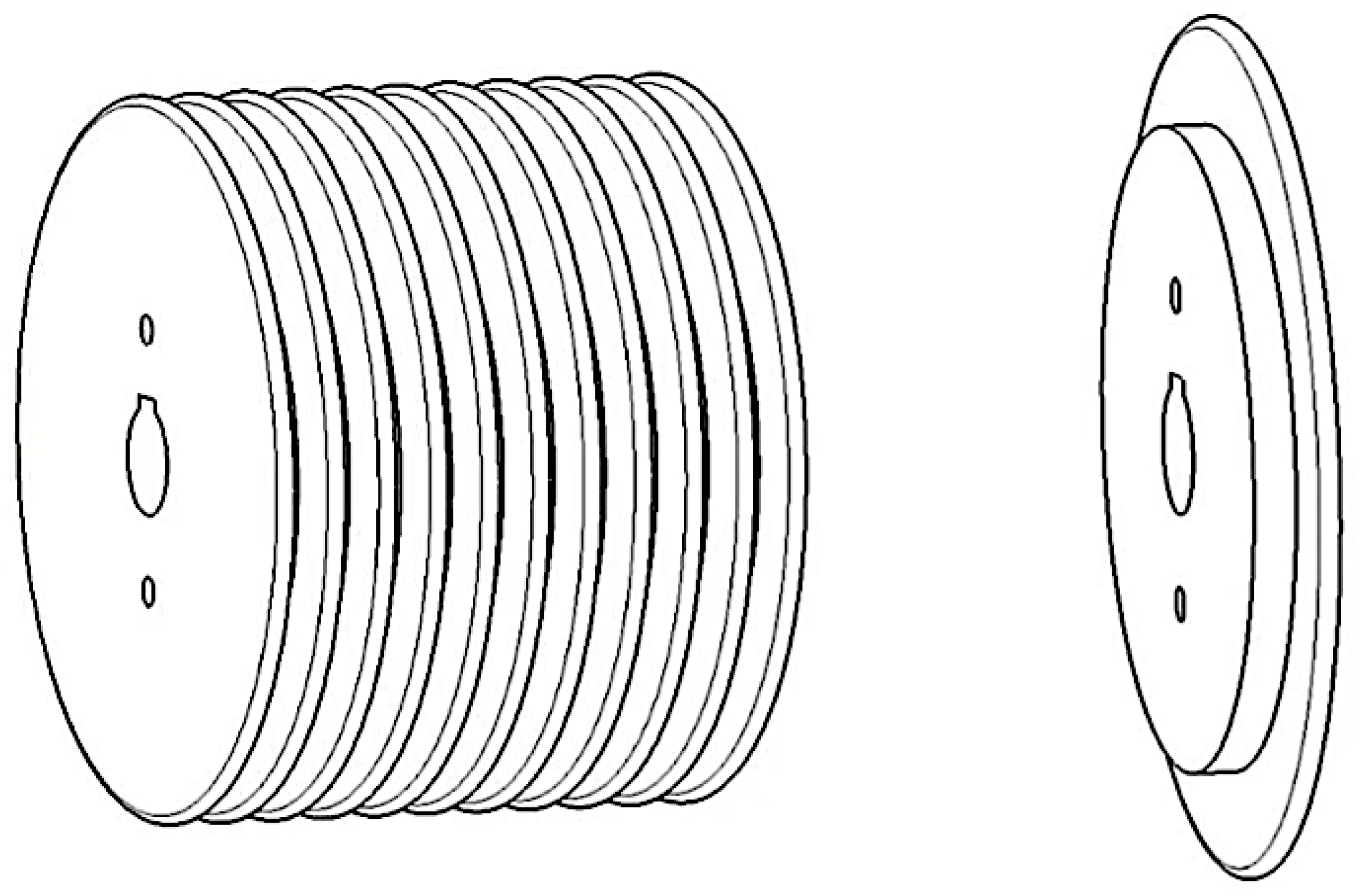
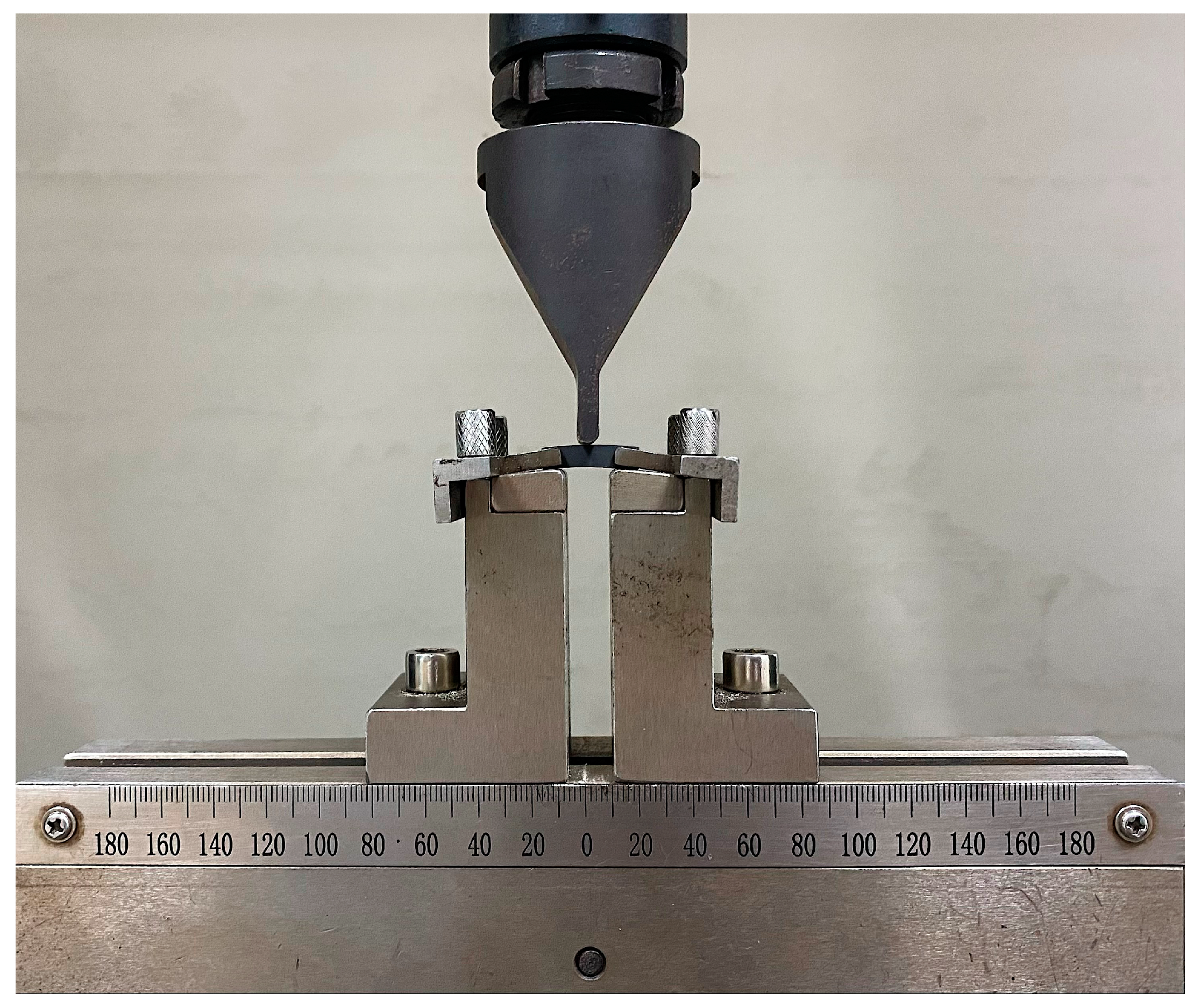
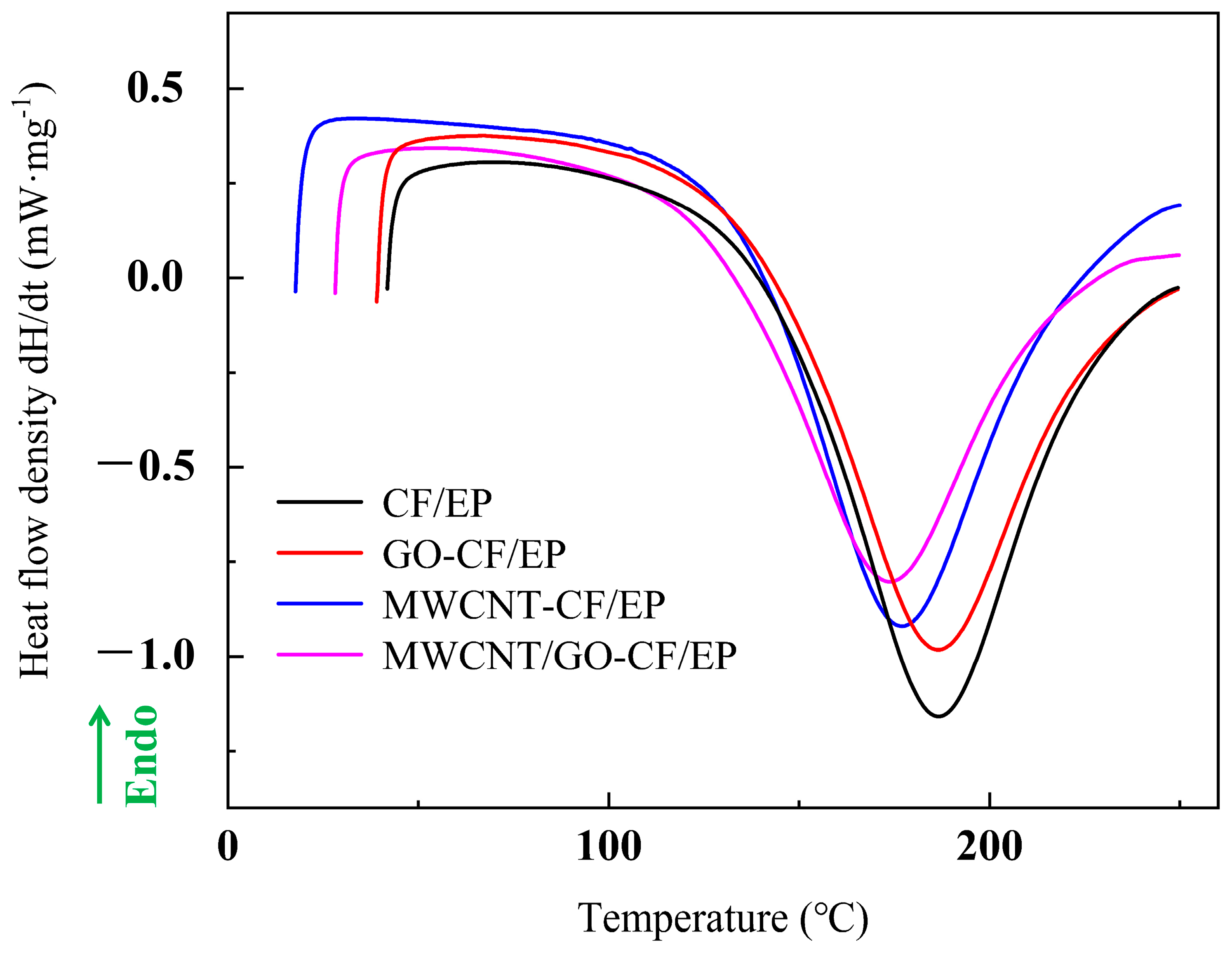
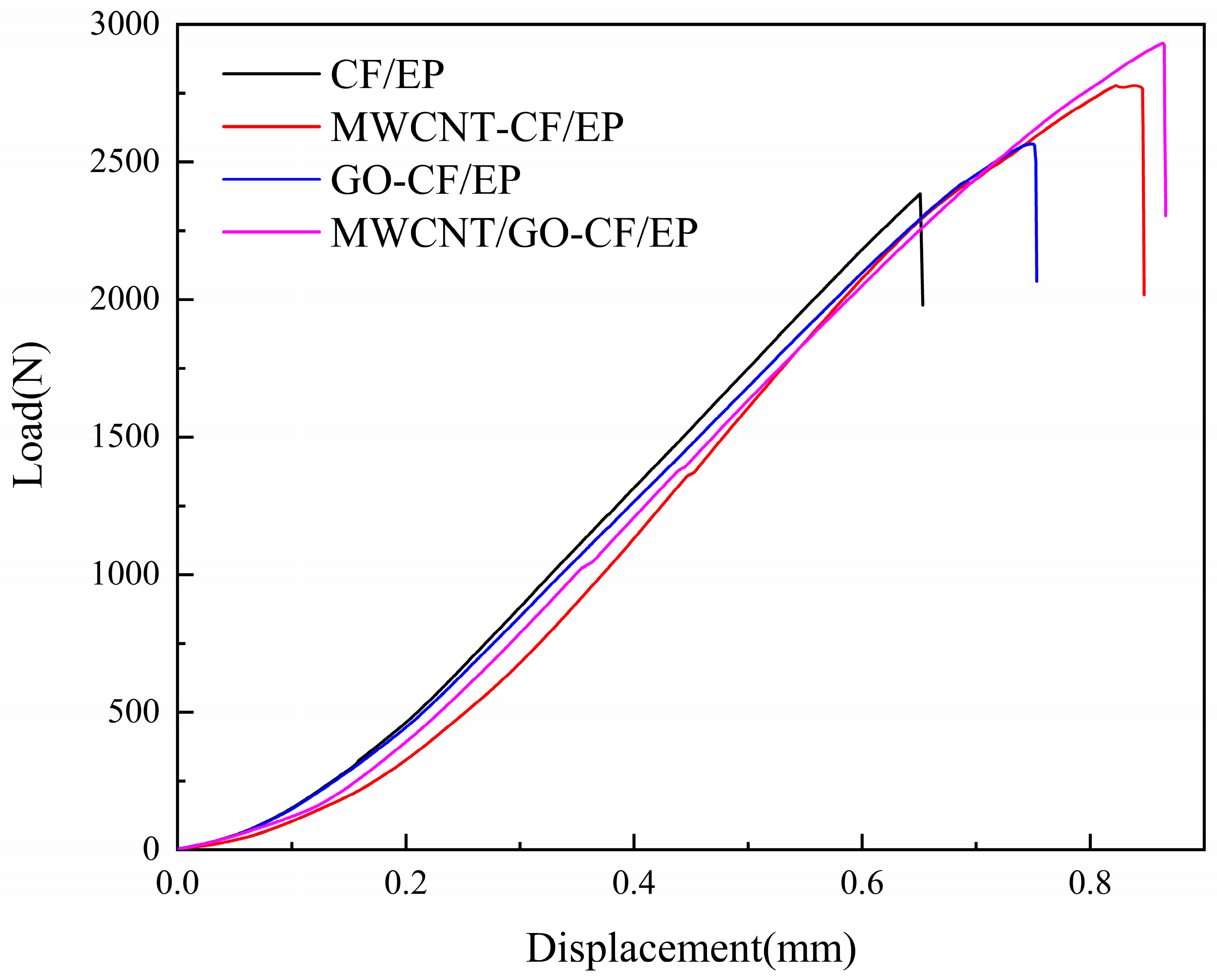
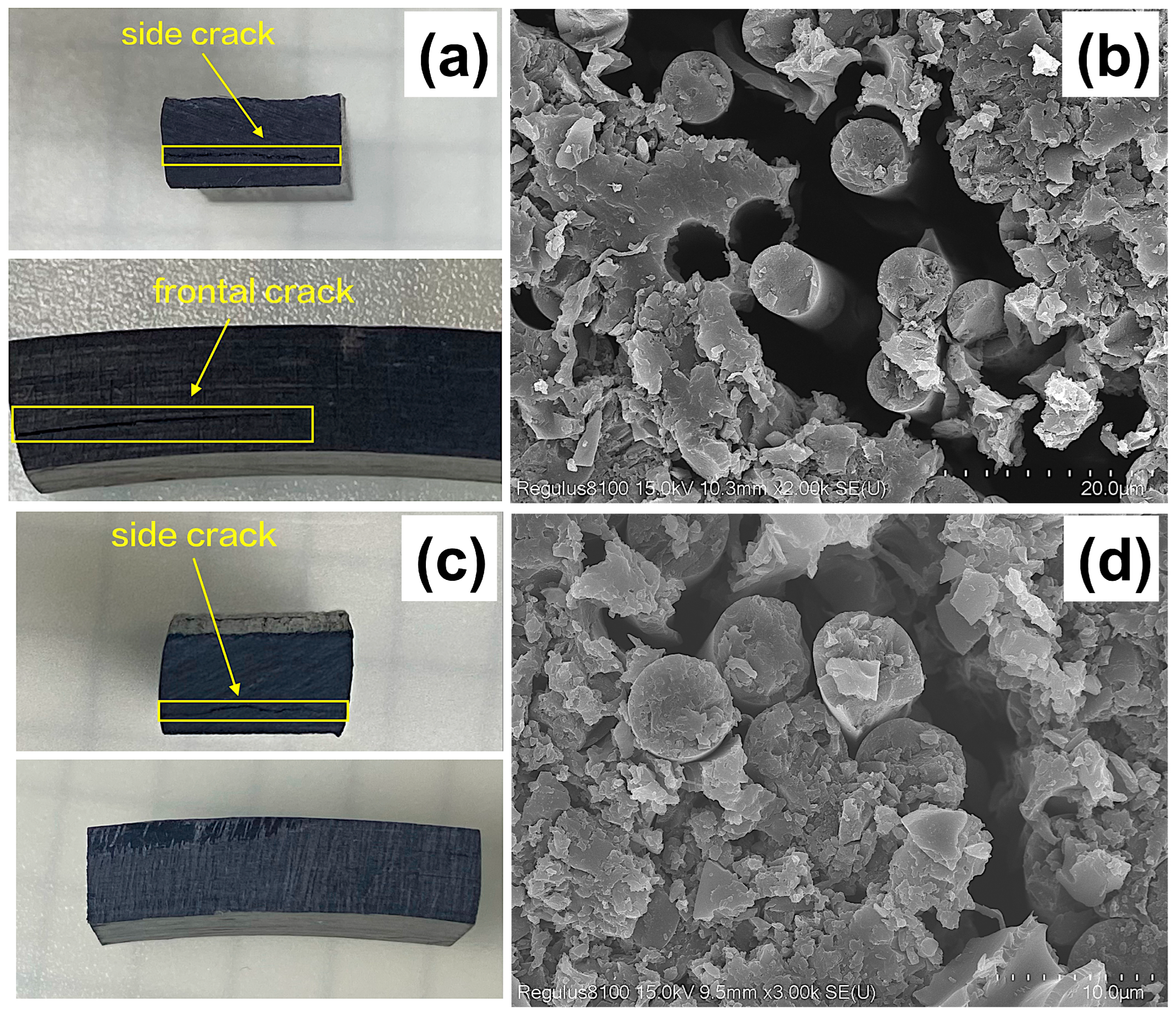
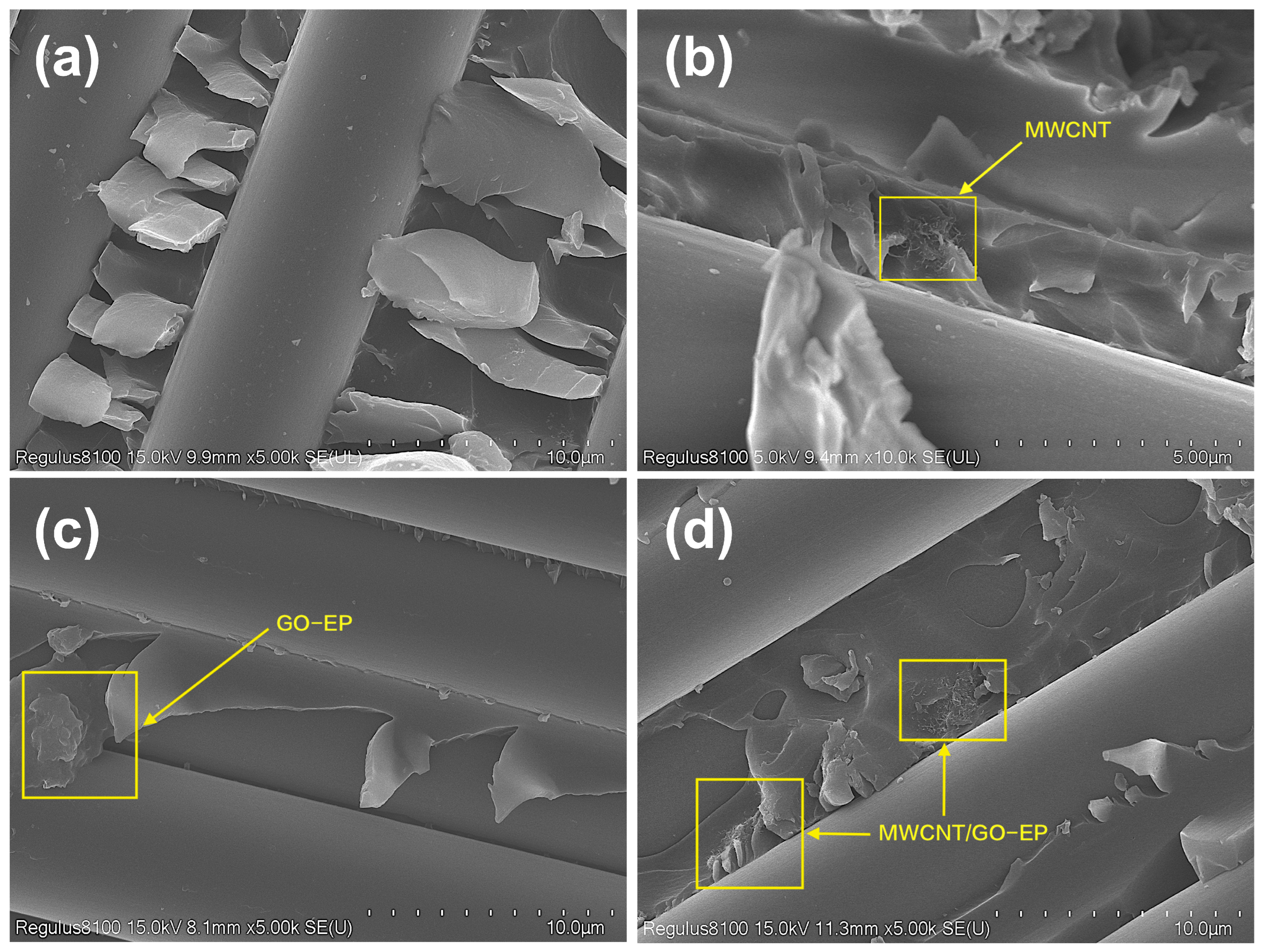
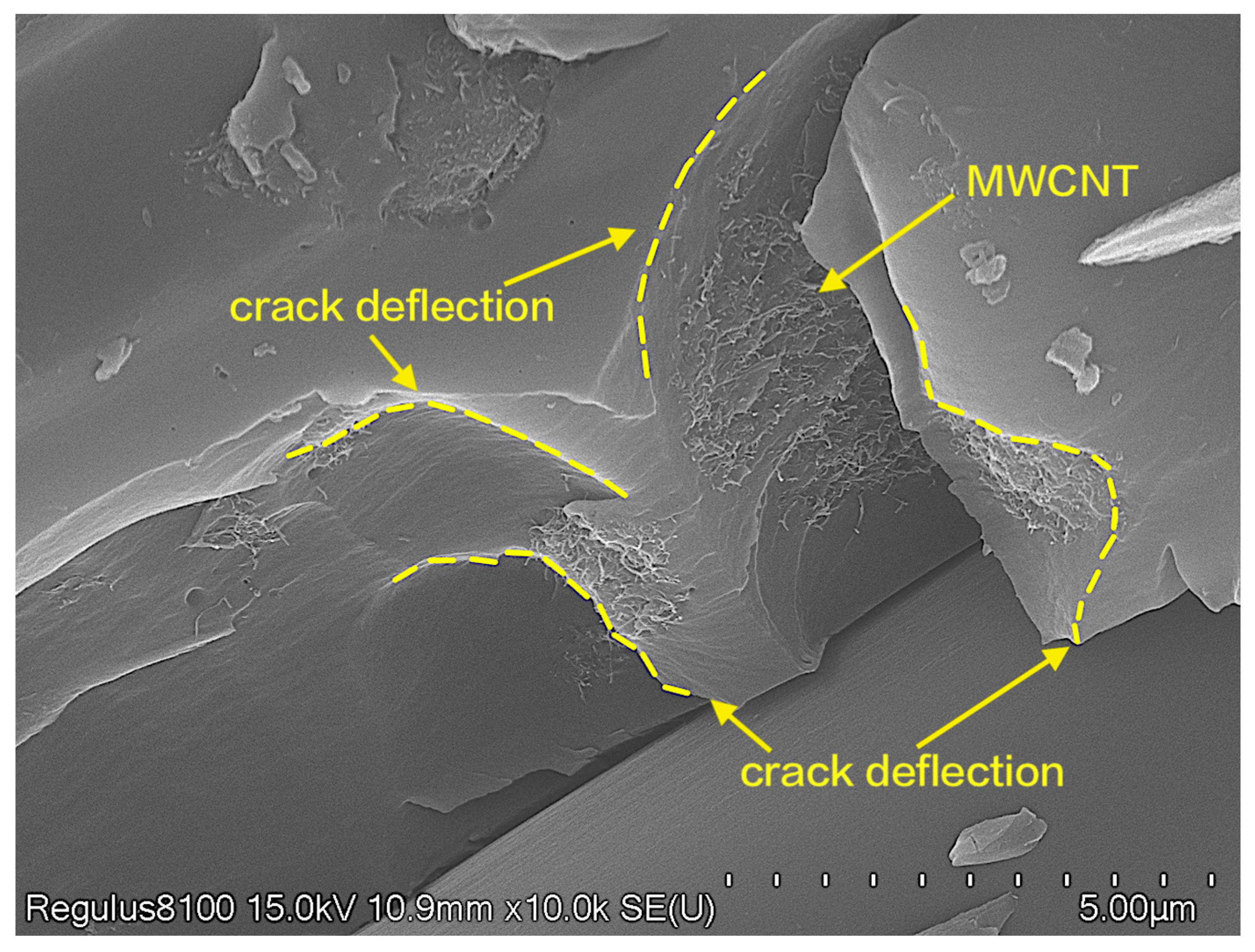
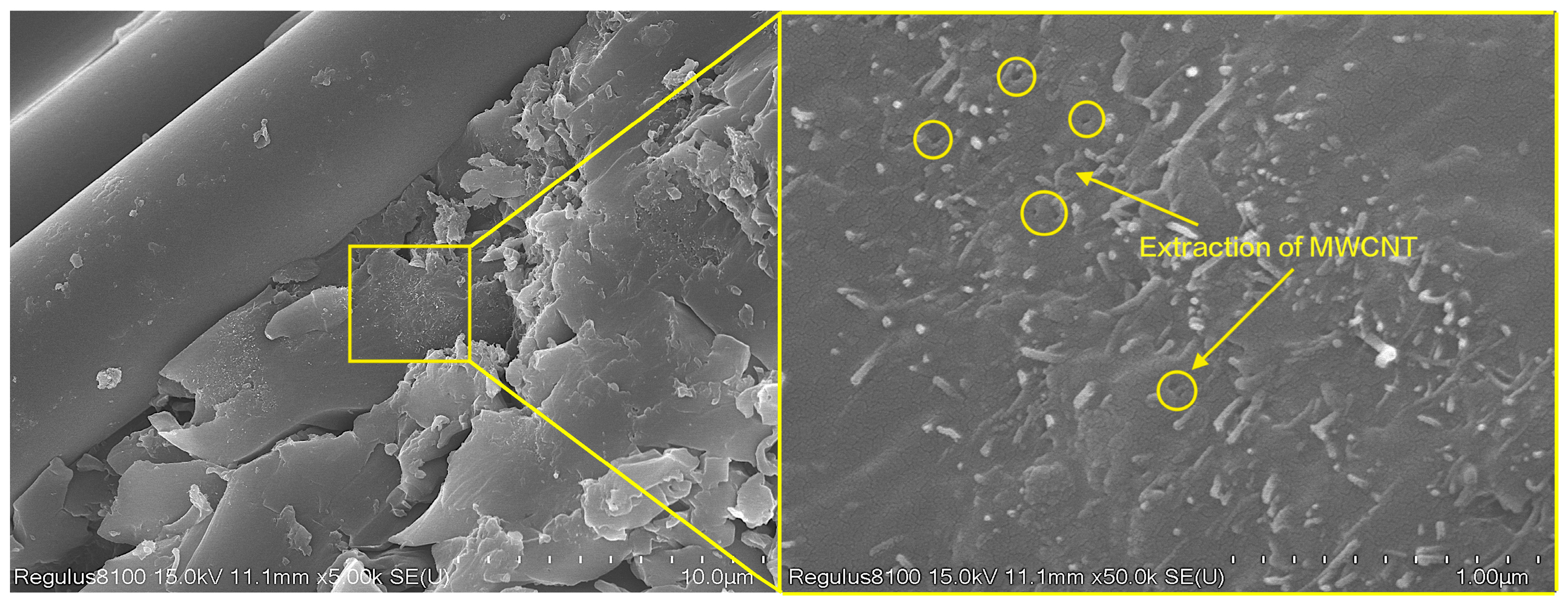
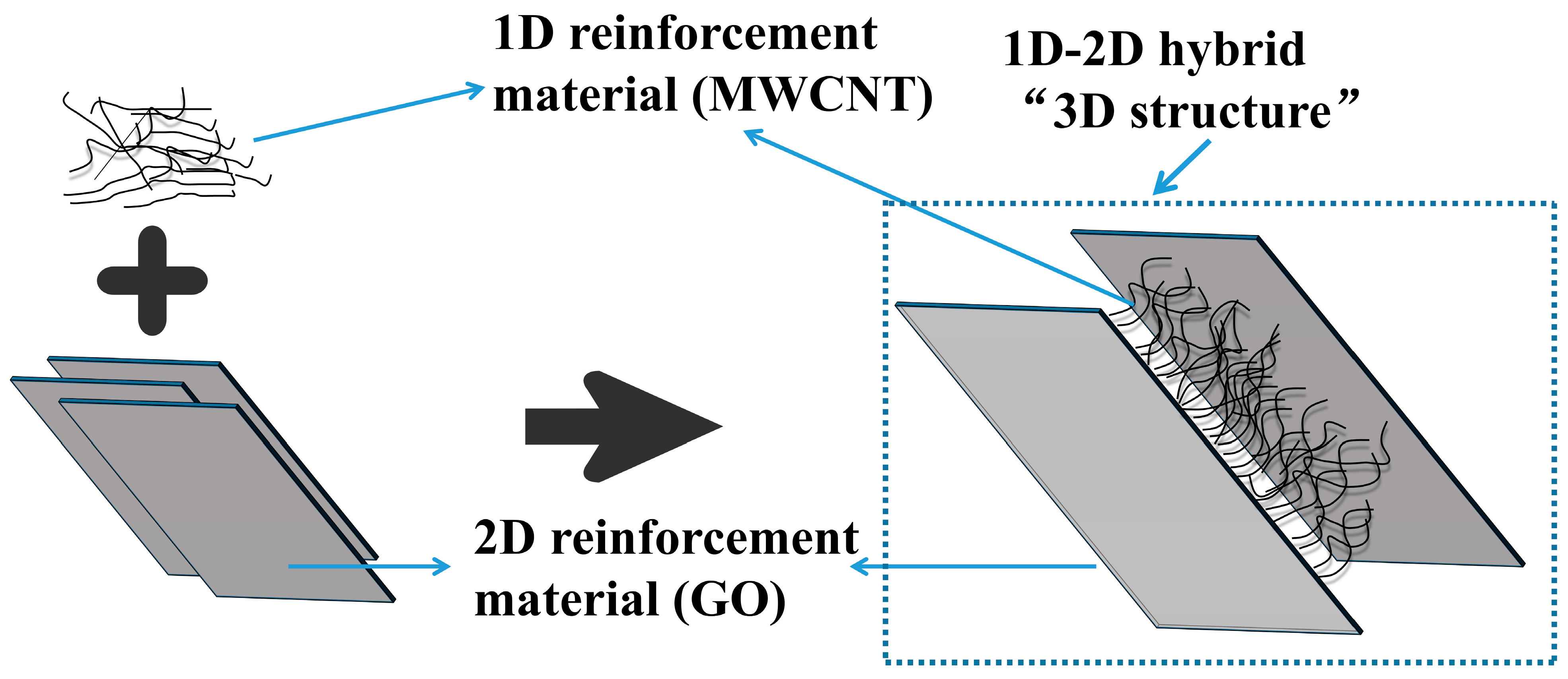
| Materials | Tow/K | Tensile Strength /MPa | Tensile Modulus /GPa | Linear Density /g·m−1 |
|---|---|---|---|---|
| T700SC-12000-50C | 12 | 4900 | 230 | 0.8 |
| Materials | Specific Parameters | ||||
|---|---|---|---|---|---|
| 5212-A | Exterior | Viscosity (mPa·S) | Epoxy value (eq/100 g) | ||
| brownish yellow liquid | 500–1500 | 0.83–0.93 | |||
| 5212-B | Exterior | Viscosity (mPa·S) | |||
| brownish yellow liquid | 150–300 | ||||
| 5212- epoxy compound | Tensile strength/MPa | Tensile modulus/GPa | Bending strength/MPa | Bending modulus/GPa | Impact strength/kJ/m2 |
| 80–100 | 3.2–3.5 | 145–170 | 3.2–3.6 | 25–40 | |
| Materials | Specific Parameters | ||||
|---|---|---|---|---|---|
| MWCNTs | Specific surface area m2/g | Bulk density g/cm3 | Diameter/nm | Carbon nanotube legth /μm | Purity/% |
| 250–270 | 60.09 | 3–15 | 15–30 | >97 | |
| GO | Layers | Single-layer diameter/μm | Thickness/nm | Exterior | Purity/% |
| 1–2 | 0.2–10 | ~1 | brown powder | 98 | |
| Intensity Parameter | Blank Group | 0.5 wt% MWCNT Group | 0.5 wt% GO Group | 0.25 wt% MWCNT + 0.25 wt% GO Group |
|---|---|---|---|---|
| interlaminar shear strength (MPa) | 55.6 | 64.98 | 60.08 | 68.7 |
| failure load (N) | 2374 | 2774 | 2565 | 2930 |
Disclaimer/Publisher’s Note: The statements, opinions and data contained in all publications are solely those of the individual author(s) and contributor(s) and not of MDPI and/or the editor(s). MDPI and/or the editor(s) disclaim responsibility for any injury to people or property resulting from any ideas, methods, instructions or products referred to in the content. |
© 2023 by the authors. Licensee MDPI, Basel, Switzerland. This article is an open access article distributed under the terms and conditions of the Creative Commons Attribution (CC BY) license (https://creativecommons.org/licenses/by/4.0/).
Share and Cite
Wen, L.; Shen, H.; Chen, Z. Interlaminar Properties of Prepregs Reinforced with Multiwalled Carbon Nanotubes/Graphene Oxide. Materials 2023, 16, 5285. https://doi.org/10.3390/ma16155285
Wen L, Shen H, Chen Z. Interlaminar Properties of Prepregs Reinforced with Multiwalled Carbon Nanotubes/Graphene Oxide. Materials. 2023; 16(15):5285. https://doi.org/10.3390/ma16155285
Chicago/Turabian StyleWen, Liwei, Haiqing Shen, and Zhuan Chen. 2023. "Interlaminar Properties of Prepregs Reinforced with Multiwalled Carbon Nanotubes/Graphene Oxide" Materials 16, no. 15: 5285. https://doi.org/10.3390/ma16155285
APA StyleWen, L., Shen, H., & Chen, Z. (2023). Interlaminar Properties of Prepregs Reinforced with Multiwalled Carbon Nanotubes/Graphene Oxide. Materials, 16(15), 5285. https://doi.org/10.3390/ma16155285





